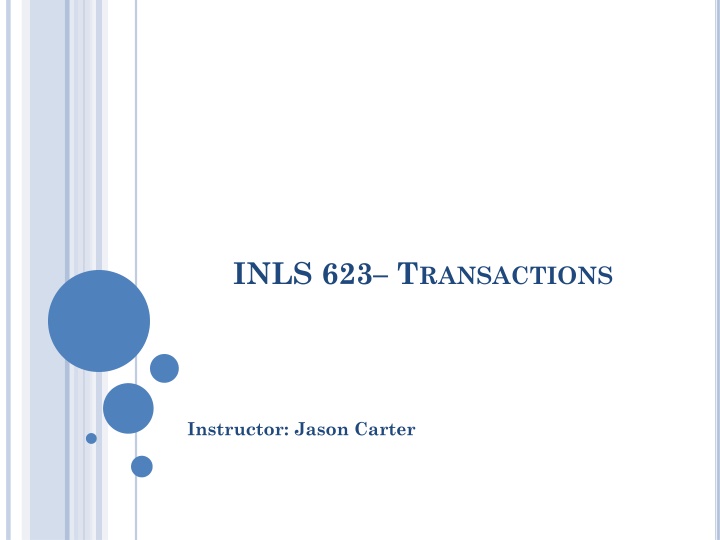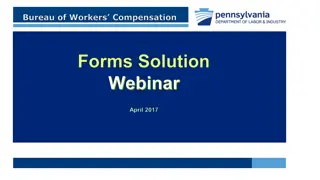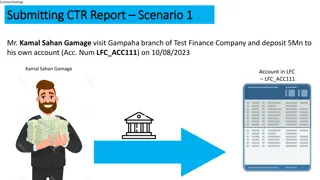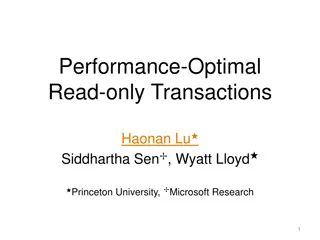
Database Transactions and Their Properties
Explore the concept of database transactions, their importance, examples, and essential properties including ACID (Atomicity, Consistency, Isolation, Durability). Learn why transactions are crucial for database operations and how they ensure data integrity even in the face of failures.
Download Presentation

Please find below an Image/Link to download the presentation.
The content on the website is provided AS IS for your information and personal use only. It may not be sold, licensed, or shared on other websites without obtaining consent from the author. If you encounter any issues during the download, it is possible that the publisher has removed the file from their server.
You are allowed to download the files provided on this website for personal or commercial use, subject to the condition that they are used lawfully. All files are the property of their respective owners.
The content on the website is provided AS IS for your information and personal use only. It may not be sold, licensed, or shared on other websites without obtaining consent from the author.
E N D
Presentation Transcript
INLS 623 TRANSACTIONS Instructor: Jason Carter
TRANSACTION A sequential group of database manipulation operations, which is performed as if it were one single work unit A transaction will never be complete unless each individual operation within the group is successful If any operation within the transaction fails, the entire transaction will fail When would you need a transaction?
TRANSACTIONS EXAMPLE Bank transaction to transfer $50 from account A to account B: 1. read(A) 2. A := A 50 3. write(A) 4. read(B) 5. B := B + 50 6. write(B) What happens if there is a power outage and statement 5 does not occur?
TRANSACTION PROPERTIES Four important transaction properties represented by the acronym ACID Atomicity Consistency Isolation Durability
ATOMICITY Transactions are atomic they don t have parts (conceptually) Transactions can t be executed partially; it should not be detectable that they interleave with another transaction
CONSISTENCY Transactions take the database from one consistent state into another In the middle of a transaction the database might not be consistent
ISOLATION The effects of a transaction are not visible to other transactions until it has completed From outside the transaction has either happened or not
DURABILITY Once a transaction has completed, its changes are made permanent Even if the system crashes, the effects of a transaction must remain in place
EXAMPLEOFTRANSACTION Transfer $50 from account A to account B Read(A) A = A - 50 Write(A) Read(B) B = B+50 Write(B) Atomicity - shouldn t take money from A without giving it to B Consistency - money isn t lost or gained Isolation - other queries shouldn t see A or B change until completion Durability - the money does not go back to A transaction
TRANSACTION STATE Active the initial state; the transaction stays in this state while it is executing Partially committed after the final statement has been executed. Failed -- after the discovery that normal execution can no longer proceed. Aborted after the transaction has been rolled back and the database restored to its state prior to the start of the transaction. Two options after it has been aborted: restart the transaction can be done only if no internal logical error kill the transaction Committed after successful completion.
HOWDOWE KEEP TRACK OF ALL THIS? Locks or timestamps are used to ensure consistency and isolation for concurrent transactions (next lectures) A log is kept to ensure durability in the event of system failure (this lecture) The transaction manager enforces the ACID properties It schedules the operations of transactions COMMIT and ROLLBACK are used to ensure atomicity
COMMIT AND ROLLBACK COMMIT signals the successful end of a transaction Any changes made by the transaction should be saved These changes are now visible to other transactions ROLLBACK signals the unsuccessful end of a transaction Any changes made by the transaction should be undone It is now as if the transaction never existed
WRITE AHEAD LOG Any changes are logged before they are actually saved on disk (to the database) If a transaction is aborted DBMS looks at the log to determine which actions need to be undone to restore the DB to its initial state If there is a system crash Recovery manager uses the log to determine whether there are any completed transactions that still need to be written to disk
FAILURES Transactions should be durable, but we cannot prevent all sorts of failures: System crashes Power failures Disk crashes User mistakes Sabotage Natural disasters Prevention is better than cure Reliable OS Security UPS and surge protectors Can t protect against everything though
SYSTEM FAILURES A system failure means all running transactions are affected Software crashes Power failures The physical media (disks) are not damaged At various times a DBMS takes a checkpoint All committed transactions are written to disk A record is made (on disk) of the transactions that are currently running
TYPESOF TRANSACTIONS T1 T2 T3 T4 T5 Last Checkpoint System Failure
SYSTEM RECOVERY Any transaction that was running at the time of failure needs to be undone and restarted Any transactions that committed since the last checkpoint need to be redone Transactions of type T1 need no recovery Transactions of type T3 or T5 need to be undone and restarted Transactions of type T2 or T4 need to be redone
TRANSACTION RECOVERY UNDO and REDO: lists of transactions UNDO = all transactions running at the last checkpoint REDO = empty For each entry in the log, starting at the last checkpoint If a BEGIN TRANSACTION entry is found for T Add T to UNDO If a COMMIT entry is found for T Move T from UNDO to REDO
TRANSACTION RECOVERY T1 T2 T3 T4 T5 Checkpoint Failure UNDO: T2, T3 Last Checkpoint REDO: Active transactions: T2, T3
TRANSACTION RECOVERY T1 T2 T3 T4 T5 Checkpoint Failure UNDO: T2, T3, T4 T4 Begins REDO: Add T4 to UNDO
TRANSACTION RECOVERY T1 T2 T3 T4 T5 Checkpoint Failure UNDO: T2, T3, T4, T5 T5 begins REDO: Add T5 to UNDO
TRANSACTION RECOVERY T1 T2 T3 T4 T5 Checkpoint Failure UNDO: T3, T4, T5 T2 Commits REDO: T2 Move T2 to REDO
TRANSACTION RECOVERY T1 T2 T3 T4 T5 Checkpoint Failure UNDO: T3, T5 T4 Commits REDO: T2, T4 Move T4 to REDO
FORWARDSAND BACKWARDS Backwards recovery We need to undo some transactions Working backwards through the log we undo any operation by a transaction on the UNDO list This returns the database to a consistent state Forwards recovery Some transactions need to be redone Working forwards through the log we redo any operation by a transaction on the REDO list This brings the database up to date
MEDIA FAILURES System failures are not too severe Only information since the last checkpoint is affected This can be recovered from the transaction log Media failures (disk crashes etc) are more serious The data stored to disk is damaged The transaction log itself may be damaged
BACKUPS Backups are needed to recover from media failure The transaction log and entire contents of the database is written to secondary storage (often tape) Time consuming, and often requires down time Backups frequency Frequent enough that little information is lost Not so frequent as to cause problems Every day (night) is common Backup storage
RECOVERYFROM MEDIA FAILURE Restore the database from the last backup Use the transaction log to redo any changes made since the last backup If the transaction log is damaged you can t do step 2 Store the log on a separate physical device to the database The risk of losing both is then reduced
CONCURRENCY If we don t allow for concurrency then transactions are run sequentially Have a queue of transactions Long transactions (eg backups) will make others wait for long periods Large databases are used by many people Many transactions to be run on the database It is desirable to let them run at the same time as each other Need to preserve isolation
CONCURRENCY PROBLEMS In order to run transactions concurrently we interleave their operations Each transaction gets a share of the computing time This leads to several sorts of problems Lost updates Uncommitted updates Incorrect analysis All arise because isolation is broken
LOST UPDATE T1 and T2 read X, both modify it, then both write it out The net effect of T1 and T2 should be no change on X Only T2 s change is seen, however, so the final value of X has increased by 5 T1 T2 Read(X) X = X - 5 Write(X) COMMIT Read(X) X = X + 5 Write(X) COMMIT
UNCOMMITTED UPDATE T2 sees the change to X made by T1, but T1 is rolled back The change made by T1 is undone on rollback It should be as if that change never happened T1 T2 Read(X) X = X - 5 Write(X) ROLLBACK Read(X) X = X + 5 Write(X) COMMIT
INCONSISTENTANALYSIS T1 doesn't t change the sum of X and Y, but T2 sees a change T1 consists of two parts take 5 from X and then add 5 to Y T2 sees the effect of the first, but not the second T1 T2 Read(X) X = X - 5 Write(X) Read(Y) Y = Y + 5 Write(Y) Read(X) Read(Y) Sum = X+Y
CONCURRENCY CONTROL The process of managing simultaneous operations on the database without having them interfere with each other
TRANSACTIONSIN MYSQL Tables where transactions will be used require the use of the InnoDB engine. START TRANSACTION- Starts a transaction COMMIT - Completes a transaction ROLLBACK - Gives up on a transaction By default, MySQL automatically commits changes To turn this off, you must type SET autocommit = 0;
CREATE TABLE accounts ( number INT, balance FLOAT, PRIMARY KEY(number) ) ENGINE InnoDB; INSERT INTO accounts(number, balance) VALUES(12345, 1025); INSERT INTO accounts(number, balance) VALUES(67890, 140); select * from accounts; +--------+---------+ | number | balance | +--------+---------+ | 12345 | 1025 | | 67890 | 140 | +--------+---------+ 2 rows in set (0.02 sec)
START TRANSAACTION; SELECT balance FROM accounts WHERE number=12345; UPDATE accounts SET balance=balance+25 WHERE number=12345; COMMIT; select * from accounts; +--------+---------+ | number | balance | +--------+---------+ | 12345 | 1050 | | 67890 | 140 | +--------+---------+ 2 rows in set (0.00 sec)
START TRANSACTION; UPDATE accounts SET balance=balance-250 WHERE number=12345; UPDATE accounts SET balance=balance+250 WHERE number=67890; SELECT * FROM accounts; +--------+---------+ | number | balance | +--------+---------+ | 12345 | 800 | | 67890 | 390 | +--------+---------+ ROLLBACK; Query OK, 0 rows affected (0.34 sec) SELECT * FROM accounts; +--------+---------+ | number | balance | +--------+---------+ | 12345 | 1050 | | 67890 | 140 | +--------+---------+






















